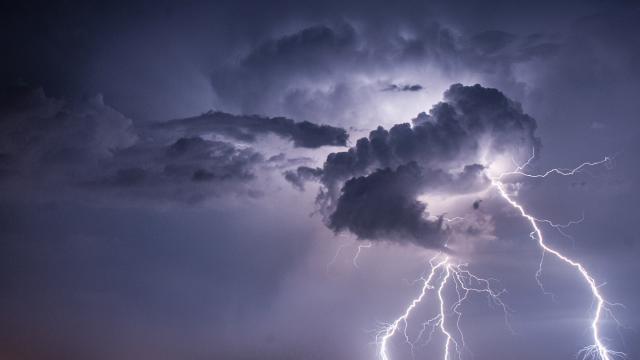In the scheme of things, a freak lightning storm near the North Pole probably isn’t the biggest concern about the rapidly warming Arctic. But it’s yet another sign that the Arctic continues to have an abnormal one this season.
Earth is struck by lightning roughly 8 million times per day. That’s 100 strikes per minute. But very few of those lightning bolts hit in the northern tier of the world, and very rarely near the Arctic. Yet over the weekend, the National Weather Service’s Fairbanks office reported lightning within 483km of the North Pole.
Brian Brettschneider, a climate expert on all things Alaska, first highlighted the bizarre weather report on the weekend. The data came from the Global Lightning Dataset, a privately created dataset using sensors deployed around the world that can detect lightning more than 5955km away. Satellite imagery confirmed the thunderstorms over the Arctic Ocean above 85 degrees north. That’s some seriously high-latitude lightning.
“This is one of the furthest north lightning strikes in Alaska forecaster memory,” the NWS said in its recap of the event. A forecaster at the office told Capital Weather Gang that the event was “certainly unusual, and it piqued our attention.”
A number of lightning strikes were recorded Saturday evening (Aug. 10th) within 300 miles of the North Pole. The lightning strikes occurred near 85°N and 126°E. This lightning was detected by Vaisala’s GLD lightning detection network. #akwx pic.twitter.com/6jdxeMPBdH
— NWS Fairbanks (@NWSFairbanks) August 11, 2019
In the tropics or even the mid-latitudes, thunderstorms are par for the course. It’s a whole different story over the Arctic Ocean, though. It takes a few key ingredients to generate lightning, but chief among them is atmospheric instability. Specifically, the lower atmosphere has to be warm and moist while the layer above is cold and dry. That type of environment helps spur convection, which in turn can spawn towering thunderheads with lightning.
The Arctic is no stranger to cold, dry air. But warm, humid conditions on the ground (or over the sea, as the case may be) is decidedly not the norm for the region. But this season has seen Arctic temperatures spike and sea ice bottoming out to near-record lows almost daily.
Now look, I’m not going to tell you a couple lightning strikes in the Arctic is proof we’re looking at climate change. But there are signs the northern latitudes are becoming more prone to lightning storms. A paper published in 2017 revealed that lightning-sparked wildfires have increased 2-5 per cent per year over the past 40 years. With climate change turning up the heat twice as fast in the Arctic as the rest of the globe, it’s likely that the unstable conditions needed to stir up lightning could become more common in the future.
Summer has been particularly out of whack for the Arctic this year. From massive wildfires to one of the most extensive meltdowns of the Greenland ice sheet on record, this season has been one of crisis for the upper reaches of the globe. The lightning is just another shocking reminder of just how odd things have been.
